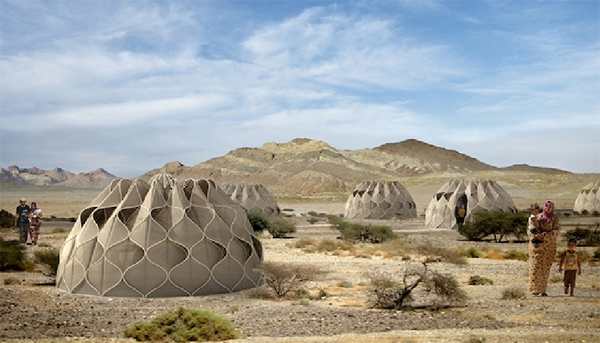
“More than 40 million people worldwide have been displaced from their homes and left to find shelter in strange lands. Maybe they find a tarp, or a tent, but their quality of life almost always remains dismal. To close this gap in need, Jordanian-Canadian architect and designer Abeer Seikaly designed a new kind of shelter. One that allows refugees to rebuild their lives with dignity.
Seikaly, now living in Amman, Jordan is well poised to design a dwelling for refugees given that her ancestors in Jordan probably toggled between nomadic and sheltered life in the desert for centuries.”
See more at: Green Prophet.com

Here is her website:
http://www.abeerseikaly.com/weavinghome.php
A link to that site was included on the Green Prophet website Owen provided, but it was extremely easy to overlook.
Some very interesting additional details are shown there.
Sorry Owen, no prices her website either, but she does have a “Contact” page on her website. You could ask her directly.
I think I’d build $200-$300 earthbag emergency shelters like our pump house. https://naturalbuildingblog.siterubix.com/earthbag-pump-house-finished/
But there’s little or no profit for anyone using low cost and recycled materials like this. Without a big push (and payoffs) from big industry I kind of doubt if earthbag emergency shelters will ever be widely used by large agencies.
Update: there’s a primer coat on our pump house now. Still deciding on the final color.
This is impressive. Shelter with extras plus it’s very nice looking. I wonder if there’s a site to get further details about it. Couldn’t find any.
The most important fact — the cost — is not given. I’ll reserve judgement until I know what they cost.
Interesting design that its packable, covered in photovoltaic cell, has inner pockets, and integrates rooftop water storage. I imagine a durable version would be cost prohibitive to make any impact on the sub standard housing situation.
Nomads have their traditional housing already, I’ll go out on a limb and say they don’t want a PV fabric tent with holes in the roof.
But regarding the refugee housing crisis in Jordan, UNICEF tents like the million in zaatari camp live in are just tents in the desert, crammed with good lower and middle class people. Since it looks as if they are there to stay, being outcasted and legally unable to work in the cities, why not make the UNICEF tents more durable and thermally efficient. The systems are already in place there. Dig out the foundation, recessing the tent a couple feet, using that soil to shore up inside the tent walls (thus no exterior plaster needed). In the desert, this thermal mass makes sense. In a land with low clay, no timber or lumber, everything is imported. Concrete rules the land. And nearby cities have EPS regrinding factories. Ship in truck loads (since thousands of trucks come in each day already to the camps) and pour a few inches of 10:1 Epscrete (twice the strength of Siberia Epscrete). Bam, dirty cheap, low skilled, thermal walls, no need to exterior plaster, insulated roof poured over a UNICEF t tent, that already has post and beam and fabric.. Seems the easiest way to humanely keep refugees sheltered. That it is cheap, quick, and sustainable is also nice ;)
Or change the law, culture and war situation so they can find a real home.
One problem is governments don’t want to create more permanent settlements, so the refugees stay in limbo year after year.